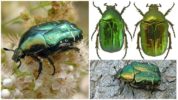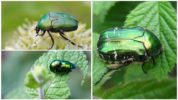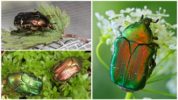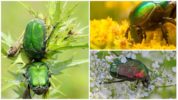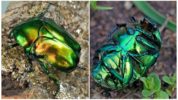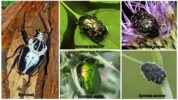- Bronze beetle
- Common bronze
- Bronze color
- Bronze beetle food
- Smooth bronze
- Types of bronzes
Bronze beetle does not mean a specific species of insect, but denotes a subfamily belonging to the family of lamellar beetles, in which there are more than 4000 species. Most bronzes are inhabitants of the tropics. At least 33 species of these beetles live in Russia. The family includes not only bronzes, but also rhinoceros beetles. Also one of the main pests of agriculture belongs to this family - Chafer.
Types of bronzes
Beetles got their name due to the metallic luster of their shell. But not always the bugs of this subfamily can be determined at a glance. Some have a simple black shell without a hint of a metallic tint. The most recognizable golden bronze is the most common and numerous species in Eurasia. Some Eurasian species:
- golden;
- smooth;
- smelly;
- furry;
- marble;
- copper.
The bronze medal of Shamil is a rare species, an endemic of intramountain Dagestan.
General characteristics of beetles
The body is short. The back line is almost straight. The transitions from the back to the sides are rounded. The head is small, directed down and forward. This family is called lamellar-like due to the special structure of the antennae, which, if necessary, the insect unfolds into a fan of lamellae.
Interesting!
The flight speed of bronzovok is much higher than that of other flying bugs.
Such success in bronzes is due to the special structure of the elytra: there are small cutouts on the sides between the abdomen and the rigid plate. Through them, insects release translucent brown wings. Elytra remain folded and do not inhibit bronze. Other bugs are forced to open elytra, which in flight stick up and to the sides and greatly interfere with flight.
Coloring
The color of bronzes is very diverse. Not always these bugs have a beautiful color. Even within the same species and habitat in bronzes, the color can vary greatly.
On a note!
Sometimes the color is formed by special secretions that completely cover the main background. Color can be with and without metallic sheen.
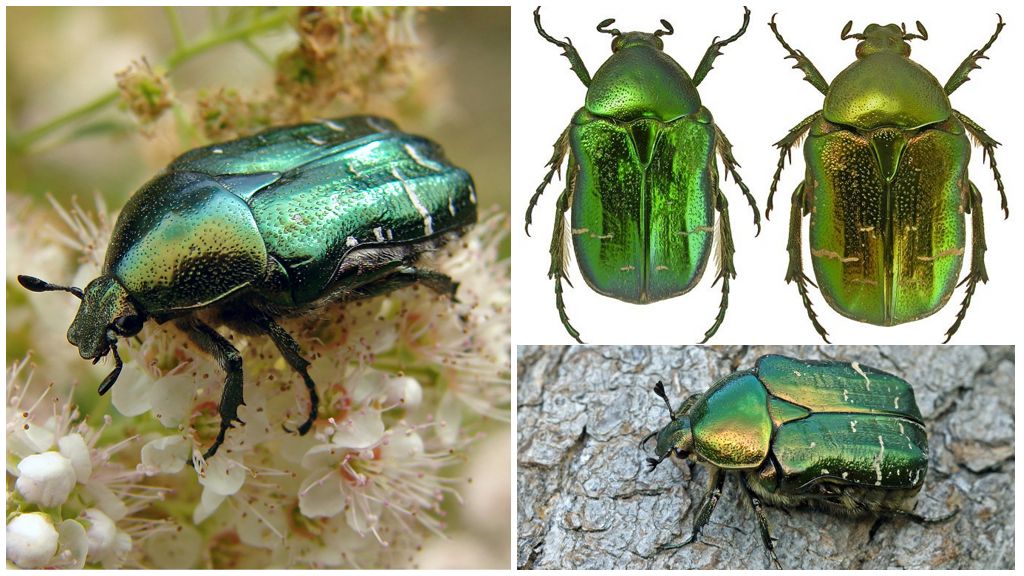
With a metallic sheen, that is, shiny, oily shiny and matte shiny:
- green with various shades - the most common in the group;
- blue
- copper red;
- Violet
- purple
- bronze;
- black with a metallic sheen.
Beetles without a metallic sheen may have:
- black;
- brown;
- brown;
- red of different shades;
- green
- yellow;
- white with an olive or gray tint.
On a note!
All members of the family have a characteristic feature: light spots that resemble the edges of scales in shape.
Spots can be:
- yellowish;
- clay yellow;
- white
- pink.
They are located on the elytra, pronotum, lower side of the abdomen and upper part of the hind legs. Spots can be of different sizes and shapes. Sometimes these marks merge, covering most of the beetle's body. Most often this happens on the elytra.
Golden bronze
Another official name for the beetle is common bronze. Sometimes it is called the green May bug.The name is completely wrong, since these two species differ not only in color, but also in structure, as well as in summer time. If we compare the bronze bronze with the May bug in the photo, removing the insects from above-back, we will see that the May belly is much longer than the elytra and has a sharp rear tip. The elytra of May are ribbed and directed at a greater angle to the ground than that of bronze.
Golden bronze is a small bug. Among Russian beetles, significantly larger specimens are found. But she can’t be called small either. The length of the bronze body is golden 13-23 mm, with a width of 8-12 mm.
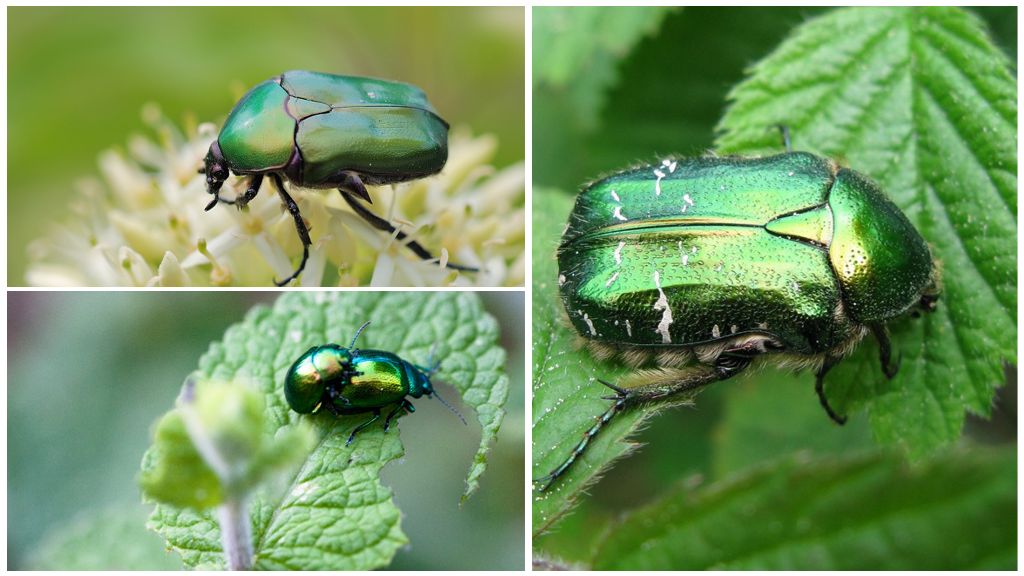
On a note!
Golden bronze has many color variations. The only common symptom: this is a beetle with a shiny metallic color. You can even find a blue bug.
Color variations
Basic painting options:
- The upper torso is copper-purple with a metallic tint. The bottom is black with a purple sheen.
- Black without shine.
- A “regular” emerald beetle, but there are no scales on the back, there are only two spots.
- Iridescent beetle. Pronotum and head emerald green with a golden tint. When illuminated from the side, the reflection is dark blue. Elytra green. When light is incident on the side, it is violet-brown. White spots are absent.
- Elytra, pronotum, and head green or golden green. The beetle is covered with bristles.
- Against the main background, large and numerous white spots that often merge into transverse wavy lines.
- The back and legs are golden red or golden green. There is a strong copper red tint.
- Dark purple color. Elytra characteristic white spots. There are no spots on the abdomen and pronotum.
- The top is copper-red or copper-brown, the bottom is bronze-green. Many spots on the elytra.
- The top is dark bronze or dark bronze green. Below is black.
- Scutellum, pronotum, and head of dark copper-red color. Elytra black and green. The lower part is black.
- Olive green color without spots.
- The upper side is dark purple with characteristic spots, the lower side is dark red with a strong violet glow.
- The back is golden green. May be copper red.
- The upper part is green or golden green, the lower is green.
- The top of the beetle is green, the back of the abdomen is purplish-red, and the thoracic side is purple.
- The top is golden green or copper red, without spots.
- Dark blue back with a green tint. White spots on elytra.
- The back is bright blue, the chest is black-blue, blue-green, blue.
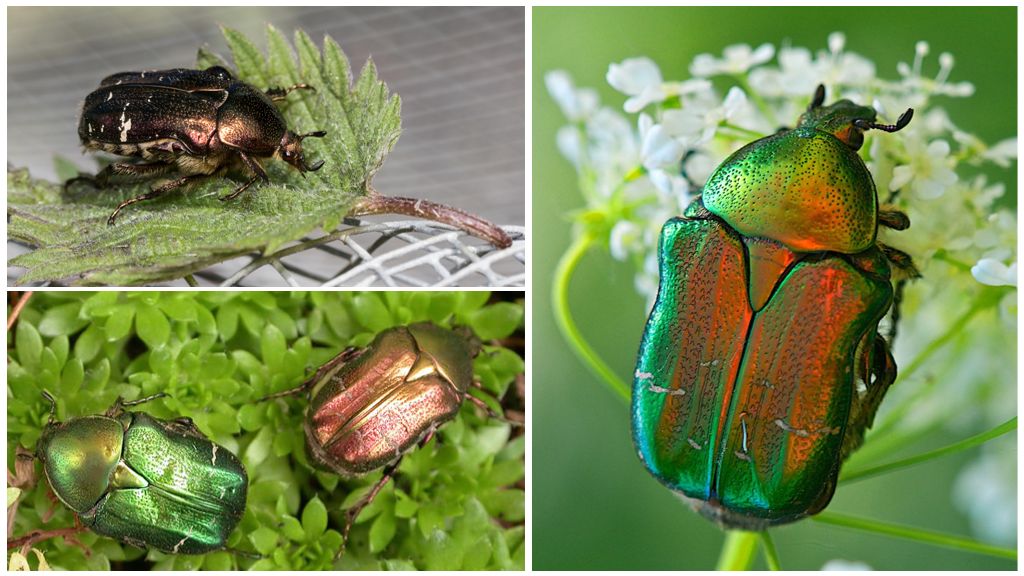
Bronze bronzes are very “democratic” in their coloring. In addition to the above, there are about a dozen different variations.
On a note!
Bronze is sometimes confused with another pearly green beetle - a mint leaf beetle. This green bug is 2 times smaller than bronze and has a convex carapace shape. It eats leaves of essential oil plants and does much more harm than bronze. But belongs leaf beetle to another family.
Lifestyle
Golden bronzes are common throughout the Eurasian continent. They are not found only in the mountains and deserts. Eating bronze flower hearts. They have a wide menu, they are able to damage the flowers of cultivated and wild plants. Very often they can be found on roses, where they climb into the very core. But bronze can not cause serious harm to the garden.
Interesting!
Gardeners do not like these insects, since they believe that the larva of a bronze beetle eats the roots of garden crops. In fact, plants are harmed beetle larvaesimilar to the offspring of bronzes.
Bronze bronzers are very light and heat-loving creatures. They are active during the day in hot sunny weather. On cloudy days, bronzes are apathetic. They sit almost motionless on the hearts of flowers and do not try to fly. In rainy and cold weather they hide in shelter:
- under the outlet of flowers;
- in the litter on the ground;
- under the roots of plants.
At night, beetles also descend to the ground.
The similarities between bronzes and May brown bugs are summer time. Bronzovka are thermophilic and the time of their life depends on the climate in the region. In the northern regions, beetles only appear in June, while in the southern years the bronzes begin in mid-May.
The period of development of a beetle from an egg to an adult can take from several months to a year, depending on when the eggs were laid. If the insect has developed before the adult stage by the fall, the adult individual hibernates in shelters and wakes up much earlier than the main summer time of this species.
What does the bronze beetle eat?
What bronzovka does not look like a May beetle is a food base. Chafer beetle damages the leaves of bushes and trees. Bronze eats the core of flowers. The larva of the May beetle (chafer) feeds on the roots of living plants. Bronze - rotting organic matter.
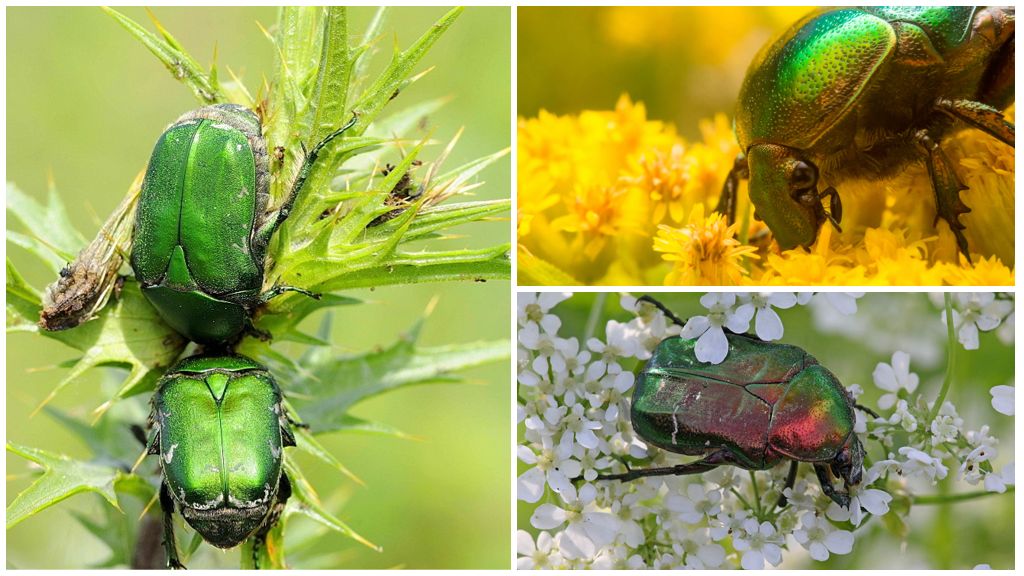
The insect eats the flowers of plants from 31 families. The list includes rosaceae, mulberries, umbrellas, cornel, buttercups and many other families.
Larva
All larval stages of lamellar beetles are similar to each other. And the larvae of representatives of this subfamily are also so similar that it’s often difficult to understand insect species not only by description, but also by photo. In order not to recall the signs that distinguish one C-shaped larva from another, gardeners prefer to fight immediately with everyone. Measures to combat the bug bronze have not been developed, since it can not cause serious damage to the crop. The years of these brilliant green beetles begin already after the flowering of fruit trees. Only individual individuals that emerge from hibernation earlier than the bulk of the bronzes can damage the flowers.
On a note!
Some types of bronzes in Russia are under state protection.
The larvae of these beetles process organics more than earthworms. As a result, the benefits of larvae are greater than the harm of adults. And given that the three species are protected, it is easier to separate different types of larvae.
The differences between the bronze larvae and the May beetle are clearly demonstrated by the table:
| Bronze | Khrushchev |
|---|---|
| Eats rotting organic | Eating live plant roots |
| The body is covered with bristles | Smooth body |
| Short, non-functional paws | Paws are long, tenacious, enabling quick movement |
| The body of one diameter along the entire length | The body is strongly thickened in the tail |
| The head is small, barely noticeable compared to the diameter of the body | The head is huge compared to bronze. The diameter of the head is equal to the diameter of the body |
| Small, weak mandibles | Powerful gnawing stingers |
At home, only those who are not afraid of worms and insects can understand the larvae. The rest just kill everyone.
On a note!
You can save the future crop by collecting adult bronzes by hand.
Smooth bronze
Very similar to one of the options for golden bronze - a smooth bronze beetle, listed in the Red Book of Moscow Region. This species prefers old forests and parks, where there are many rotten trees.
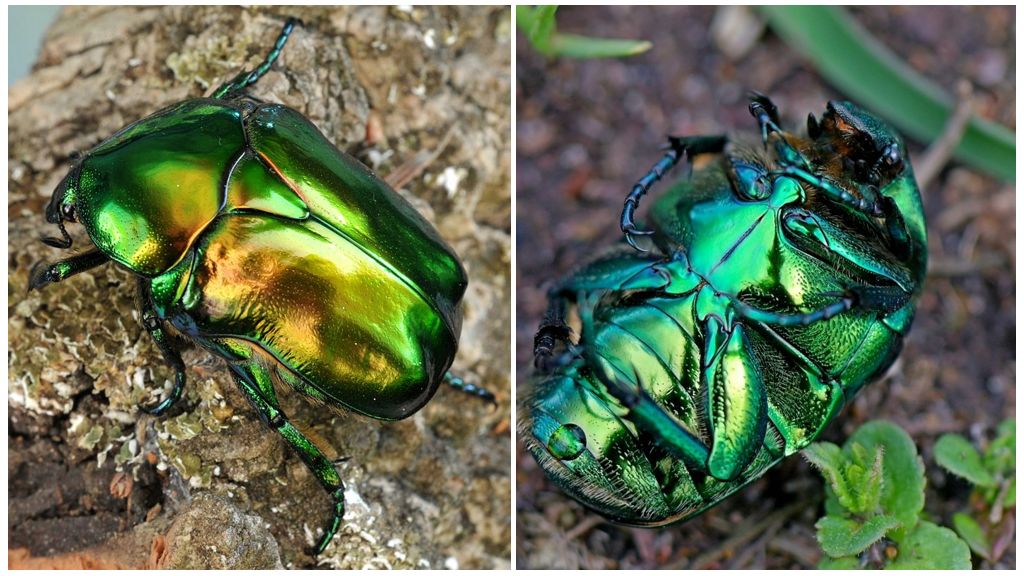
Distributed in southern Europe. In Russia, in the north, the border of the range passes through Kaliningrad, Voronezh, Samara. In the south - across the border with Ukraine to Orenburg.
This beetle with a green shiny back is larger than the "relative". His body length is up to 3 cm. There are no white marks on the elytra and cephalothorax. Elytra cast with either golden or copper-red sheen. Legs and underside with bluish tint.
Marble
An analogue of the golden bronze with a green shell decorated with white markings. In marble, a greenish tint of the shell is often found. Body size is slightly larger: up to 27 mm.
Distributed throughout Eurasia, except for the mountain forests of the Caucasus and Crimea. Prefers flat forests. Settles on old trees. The species is numerous, but insects are found alone. These beetles are active from June to August in the European part of Russia and from mid-May to mid-August in Ukraine.
The life cycle in warm regions takes 1 year, in the north - 2 years.Females lay eggs in the old stumps of some tree species.
Bronze Shamil
Little-studied endemic of Intragornic Dagestan. Until 1981, it was considered an extinct species. The color is dark bronze green. The upper body is matte, the lower is shiny. Body length 2 cm.
They are found on various plants. Larvae develop in the soil, feeding on detritus.
Smelly
Other names: pockmarked deer or fetid deer. A small shiny black beetle. Body size up to 13 mm. There are many small white spots on the elytra. The body is covered with thick white bristles. Lives in warm regions, including the south of Russia.
Pest agriculture, as the larvae eat the roots of plants. The imago feeds on pollen. Years begin in May.
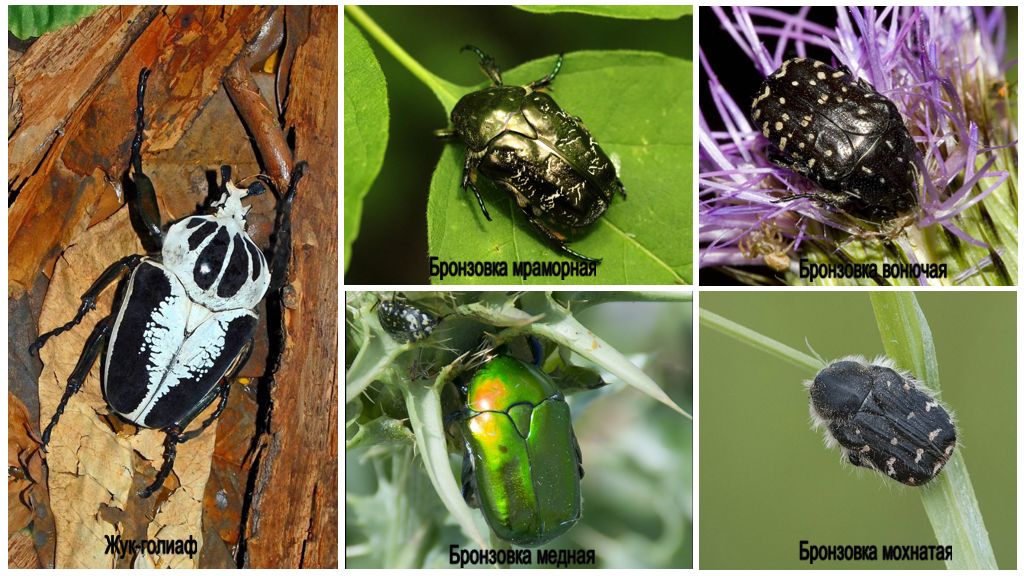
Shaggy
Beetle 8-13 mm in size. Coloring is black, matte, with yellowish or white spots. The pattern of spots is very variable. The bristles on the body are two colors: white and gray. The underside is covered with thick, light hairs. Adults eat buds and flowers, larvae eat rotting organics. Shaggy bronze is one of strawberry pests.
Copper
The view is very similar in appearance and size to a smooth bronze. The sizes coincide. Body length 1.6-2.5 cm. Elytra and pronotum green with a golden tint. The head, lower body and legs are black with a purple tint.
It lives in southern Europe. Found in Cairo. In Russia, this species is absent.
Genus Goliathus
Or goliath beetles. The largest representatives of the bronze subfamily. The weight of the beetle can reach 100 g, and the body size is 11.6 cm.
Interesting!
The largest species of the genus is Goliathus regius, with a body size 2 times larger than a mouse.
The large green beetles of the species Mecynorrhina torquata are slightly inferior in size to Goliathus regius. The length of the male can reach 8.5 cm.
The main color of the genus is black with white spots. Sometimes there is more white in color than black.
Goliaths are inhabitants of Central and Southeast Africa. They are not found in Russia. If such a bug was found on Russian territory, it means that he escaped from someone from the terrarium.
